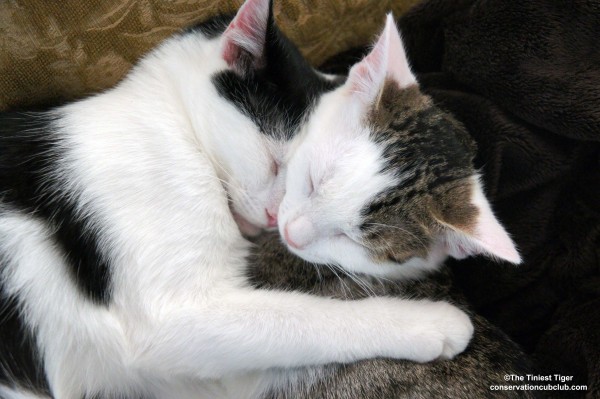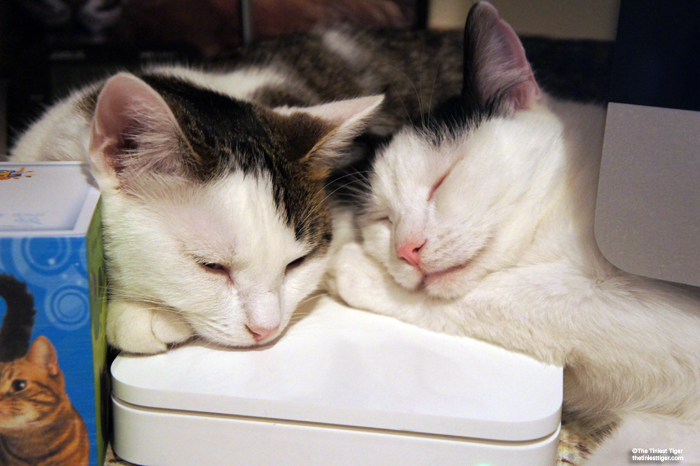 I wonder if we could even find a cat owner that supports the myth of the asocial cat? Yet, almost every day we read or hear some tired old stereotype about our feline friends. This habitual repetition that cats are asocial is the subject of internet memes, jokes and unfortunately perpetuated on many television sitcoms.
I wonder if we could even find a cat owner that supports the myth of the asocial cat? Yet, almost every day we read or hear some tired old stereotype about our feline friends. This habitual repetition that cats are asocial is the subject of internet memes, jokes and unfortunately perpetuated on many television sitcoms.
Cats Have the Characteristics of Social Animals
Social animals form long-term bonds, live in family groups or live in larger stable membership groups such as a feral colony. Members of a social group display individual recognition, cooperative behavior and reciprocal communication. Cats, like other mammals, care for their young and must interact to mate. Cats also exhibit dominant and subordinate relationships with each other.
Solitary behavior is more common in cats when food is scarce, but when food resources are present and plentiful to support them, cats form social groups.
When I began thinking about how the cat is misunderstood and in light of recent internet echoes about how cats just don’t care about their owners, I thought I would start by looking up the word asocial in the dictionary on my iMac. And what did I find?
asocial
adjective
avoiding social interaction; inconsiderate of or hostile to others : the cat’s independence has encouraged a view that it is asocial.
That’s right, the definition of asocial uses the cat’s independence as an example! We have our work cut out for us.
The next time you are told cats are asocial, keep these three cat behaviors top of mind for a comeback that busts the myth of the asocial cat.
1) Cooperative Rearing of Their Young
The most prevalent amount of cooperative behavior happens among queens, especially related queens. These female cats work together to rear their kittens, which includes communal nesting, nursing, grooming, guarding and even midwifing behavior. Midwifing is rare in nonhuman species but is known to occur in cats. Cats have been observed cleaning both the newborn kittens and perineal area of the queen giving birth.
2) Head Butting and Nose Taps
If you are a cat parent, you might agree that one of the most endearing social interactions between you and your cat is head-butting. This social behavior is more than likely the cat equivalent of hugging and handshaking in humans. This behavior is more prevalent in feral cats than between house cats. When head butting, the cats are exchanging scents. One theory is that this exchange of scents enables a returning hunter to smell like the colony again. Your cat’s habit of rubbing against your legs, especially when you return home, is your cat’s way of welcoming you back into the group. You in turn, pet your cat as a way to exchange your scent.
Best friends, or preferred associates often form within a colony. Two or more cats will associate more closely with one another than they will with other members. These best friends groom, rub, and show increased physical contact. The availability of resources is not the cause. These cats are together because of a social bond.
Cats that are more familiar with each other, such as those that have lived together longer, are more likely to be best friends than cats that are less familiar with each other. Annie and Eddie were paired up as kittens at Grayson County Humane Society and their bond is strong today.
3) Social Learning
Adult cats help socialize kittens. This social learning occurs from 2-16 weeks and beyond. Adult cats teach kittens how to hunt and how to get along with other kittens by not playing too rough. If a kitten is isolated from other cats at a young age, this kitten may be socially awkward if another cat is introduced into their home at a later date. This may have been the case with our Gracey and with Maggie. These cats are happier as the only cat in the home with their human family.
Your Cats Says I Love You Every Day
It is not just food that brings cats together. Observation confirms that cats are intrinsically drawn to one another. Cats are social creatures in their own way just as each species has its own social pattern and should not be compared to humans or dogs to determine their sociability.
Remember, when your cat tucks her head down soliciting scratches and petting she is wanting to simulate grooming behavior. Grooming is a touch-related bonding activity that makes cats feel happy, comfortable and safe. Your cat is saying you belong to me, you make me feel safe, secure and happy, which is your cat’s way of expressing love and there is nothing asocial about that.

What a wonderful post.
Sue B